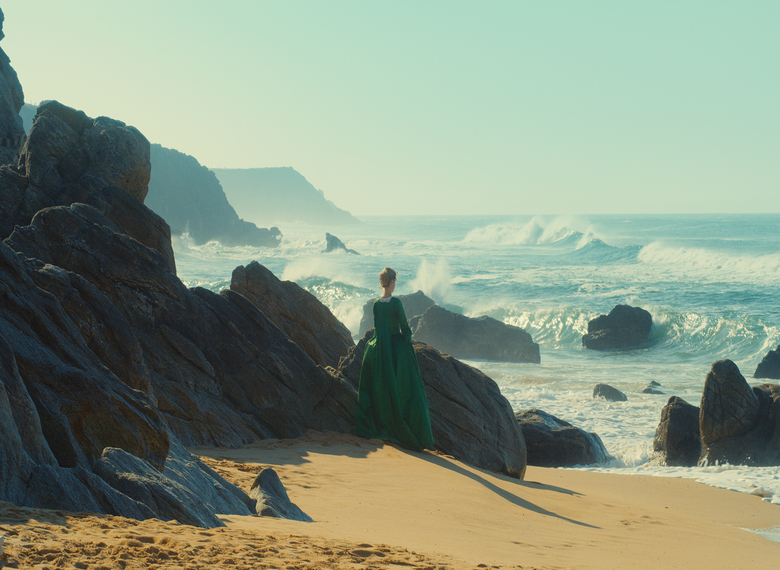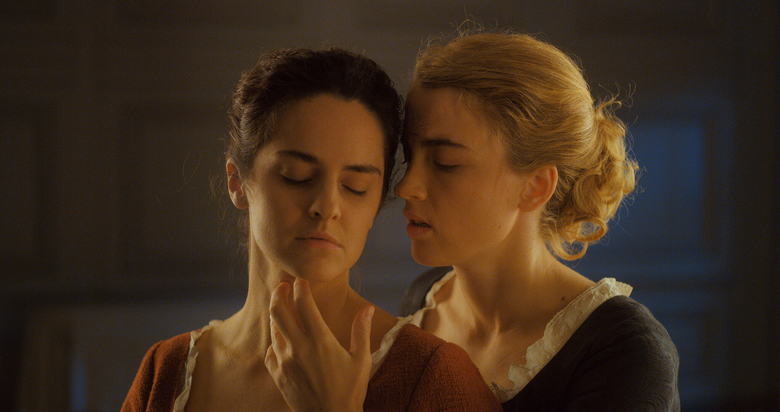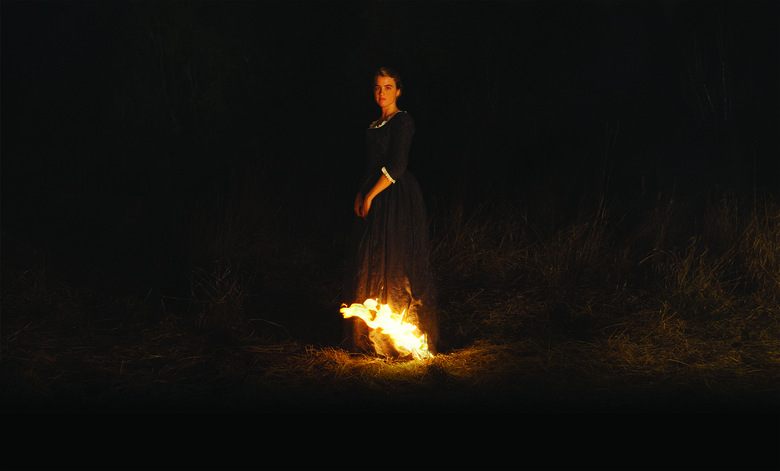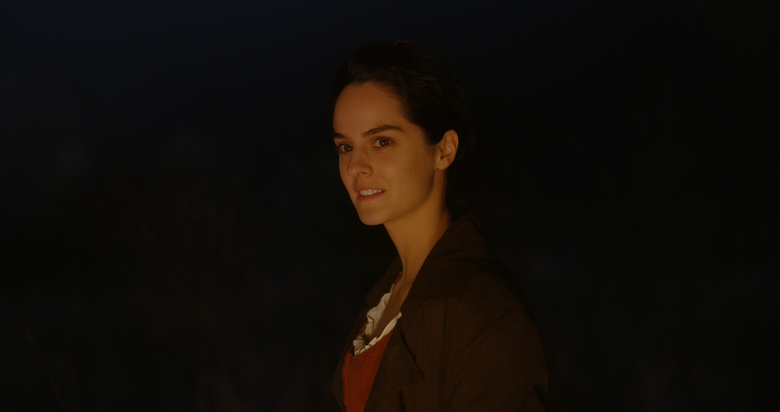Employing a minimal soundscape and meticulously calibrated gaze, Celine Sciamma’s 18th century lesbian romance Portrait of a Lady on Fire (2019) understands the experience of love as a function of time. Its slowness creates an ideal tempo for the simmering of queer desires. With it's efficient opening sequence, Sciamma establishes formal guidelines for how the film is meant to be experienced.
The temporal structure takes us from the film’s present to the past of memory, or what theorist Gilles Deleuze calls “a sheet of the past.”1 The opening credits are displayed on quick close-ups of blank sheets. Hands enter the frame and draw lines unto the page, making an intensely tactile sound. Sciamma then cuts to various individual close-ups of female art students in a drawing class as they listen to the slow, detached directions of their teacher, Marianne. “Don’t go too fast. Take the time to look at me,” she advises.2
The silence of the classroom is palpable and allows for the viewer to pay attention to the subtleties of the film’s soundscape and appreciate the weight of Marianne’s words. Such a focus is key to watching the film, and Marianne’s advice to take the time to look at her is also important for the viewer, who will spend much of the film observing the nuanced ways that Marianne and Héloïse pay attention to each other within their captivating chemistry.
The camera cuts to a medium long shot of our protagonist posing with a motionless, teacherly composure that is quickly disrupted as she notices that an old painting has been brought out by one of her students. Sitting next to one of her classmates, the culprit asks if Marianne painted it. “Yes,” she responds solemnly, and the camera’s focus racks from the two girls and onto the painting.3 “A long time ago,” she utters as the sound of an ocean wind subtly begins to creep into the soundscape.4
The camera dollies magnetically towards the painting, which depicts a woman walking through a moonlit field with the bottom of her dress aflame. “What’s it called?” the student asks, the painting now framed in a close-up where its dimensions nearly match that of the screen.5Cutting back to Marianne, the camera moves from a medium shot to a medium close-up with an intense forward momentum that matches the speed of the shot that preceded it. Almost as if announcing the name of the film, Marianne responds “Portrait of a Lady on Fire.”6
In harmony with the force of Noémie Merlant’s performance as Marianne, the magnetic camera movement and increasing sound of the ocean summon an almost suffocating sensation of a memory coming back to life, portraying what Deleuze calls “an effort of evocation.”7With the crash of a wave, we are propelled back into a sheet of the past where Sciamma begins the film’s extended recollection image. Marianne is sitting in a rowboat many years earlier, making her way to the island of Brittany where she will be tasked with painting the wedding portrait of her future lover without her sitter being aware that she is being painted.
At just over two minutes, this opening efficiently and reflexively reveals the temporal structure of the film. While the painting summons a palpable yet unrevealed feeling which in forms the inaugural camera movements, Sciamma’s film endeavours to offer what the painting cannot by painting a portrait of time.
"The unspoken queer desires between the women are at a melting point, and the sequence renders the simple act of paying attention to someone to be almost unbearably sexy."
The film takes its time following Marianne’s time in Brittany, slowly establishing the rhythms of life on the island and further articulating the film’s detailed soundscape. Beyond the distinctive waves that pulled us into this extended memory, the sonic character of the film’s world is distinguished by the crackling of the fireplace, the subtle chirping of birds, the sounds of footsteps upon the manor’s hardwood, and the distinctive noise of Marianne’s brush stroking the canvas. While the film rarely uses depth of field, which Deleuze suggests creates a strong connection with memory in Citizen Kane (1941), it is perhaps the depth of the film’s vivid sonic character that serves a similar “function of remembering”8The film’s silences are particularly palpable, allowing the spectator to live within Marianne and Héloïse’s initially prickly chemistry, noticing the fluctuating tensions and desires that spark between them.
The two women barely have a formal introduction, and hardly a word is spoken between them on their first walk together, as a likely suspicious Héloïse walks ahead of Marianne, preventing the painter from memorizing her unknowing subject’s face. A notable close-up at the end of this walk features Marianne, framed in profile, looking out at the sea, then turning her head to get a glimpse of Héloïse. Whenever Héloïse turns to look back at her with an intense gaze Marianne turns away again. The camera’s focus swiftly racks between Heloises’ look and Marianne’s head which eclipses it, charting the hesitance of her gaze. However, the way this gaze operates will change as Marianne’s perception of her subject expands during the film.
The film’s slowness is essential to its nuanced development of desire over time, but the queer optics of this timeliness are challenged by Rosalind Galt and Karl Schoonover’s arguments around the queer potentials of slow cinema.9They suggest that “like the wilfully unproductive queer,” slow cinema offers the potential to aesthetically “resist the socially sanctioned narrative pathways” enforced by classical cinema.10Sciamma meticulously manages the gaze, and the passing of time is rarely emptied of narrative context. Thus, it would be natural to place the film into the category of “faux slow” cinema that Galt and Schoonover so cynically describe, but I would argue that the film is deserving of a more nuanced approach.
I am hesitant to conclude that the focused gaze of Sciamma’s camera trumps the queerness of the film’s subdued tempo, particularly considering how it is concerned with how the act of looking simmers lesbian desires during an era in which same sex attractions were socially outlawed. Sciamma’s lesbian gaze offers a profoundly subjective mode of spectatorship and should not be read as a simple regression to the hegemonic modes of looking enforced by classical Hollywood cinema. Like her protagonist, Sciamma uses certain formal conventions of her field and riffs them into something distinctly queer, feminine, and lively. Both women are limited by the aesthetic conventions of their respective artistic practices but make attempts to bend the rules.
"With the camera’s gaze locked onto Héloïse, the concluding shot may not offer much freedom for the roaming eye, but the duration of the sequence certainly offers a depth of feeling and memory to a roaming (and likely aching) heart."
How Marianne navigates the artistic conventions of her era is directly related to the film’s concern with the gaze. What she processes from the intensified attention she pays to Héloïse over their time together is manifested in the two portraits she paints of her, capturing two vastly different depictions of her. When she shows Héloïse the first “draft” of her wedding portrait shortly after revealing herself to be a painter and not simply a walking companion, Héloïse is deeply offended by the depiction. A close-up of Héloïse’s lifelessly content face in the portrait contrasts with the fiery reaction which follows it. “Is this how you see me?” she responds, angry not only about the duplicity of her new friend, but also of the inaccuracy of the image from someone who she thought was beginning to truly understand her.11“The fact that it isn’t close to me, that I can understand. But I find it sad that it isn’t close to you” she berates her.12Marianne’s adherence to the conventions of 18thcentury painting has leached her work of any life and feeling. Marianne destroys the painting and Héloïse agrees to pose for her. The painter wants to understand her subject with the emotional depth she deserves just as the subject wants to be properly seen.
This development alters the dynamic of looking between the two women, allows for a greater sense of desire to develop between them, and for deeper feelings to be unlocked. The shift in the gaze is apparent in a scene where Marianne and Héloïse list off the mannerisms they have observed of each other during their time together. Standing behind the canvas, Marianne notices “When you’re moved, you do this with your hand [...] and when you’re embarrassed, you bite your lip. And when you’re annoyed, you don’t blink.”13Annoyed, Héloïse challenges the assumption that she is a passive subject, that the artist has been the only one looking –an assumption that the audience may have made up until this point as well. She demands for Marianne to stand next to her, on the other side of the canvas.
Emphasizing the sexual tension of the encounter, the camera moves from a medium shot to a medium close-up of the women as Héloïse directs Marianne to look away from her. In scenes of intensity such as these, the silences allow such thematically essential and emotionally intelligent pieces of dialogue to resonate more deeply. Sciamma’s formalism invests equal attention to her characters’ words. In the silence that follows, the unspoken queer desires between the women are at a melting point, and the sequence renders the simple act of paying attention to someone to be almost unbearably sexy. In effect, we can observe a stunning interplay between the film’s slowness, the assumptions that the gaze can provoke, and the feelings that it can unlock over time.
As the dynamics between the women transform from an aching desire to becoming passionate lovers, the function of the film’s slow tempo and careful gaze begin to change. A pivotal shift occurs when Marianne, Héloïse, and their maid Sophie attend a bonfire populated by witchlike women, who begin to sing a lively acappella hymn. The camera smoothly tracks across the line of women, each adding their own piece of harmony and rhythm to the tune, before the film cuts to an exchange of looks between Marianne and Héloïse. In a film where silence is so carefully calibrated, a moment where the soundscape is dominated by lively music merits serious attention.
Initially smiling at each other in awe, the energy of their exchange of looks changes when Héloïse’s turns directly towards the camera in her long shot, her eyes profoundly serious and welling with tears. Without the distinct silence living between the women’s wistful gazes, the passionate music and the literal flames between them suggests a mutual willingness to confront their unspoken feelings with a greater sense of shared intuition. The music crescendos, then pauses in a moment of dramatic silence. Héloïse’s long shot follows her as she walks to the left of the fire, revealing that the bottom of her dress is now ignited. As she nonchalantly observes the flame, one might observe that Marianne is witnessing the emotionally ambiguous image which first activated the film’s plunge into the past. Her reaction shot is similarly unbothered, as if the threat of a flame is insignificant in comparison to the feeling of seeing and being seen.
Following their consummation of queer desire, it quickly becomes apparent that the women’s time together is limited, and the film’s timely concerns shift from using delay to provoke desire to an interest in savoring, or even slowing down time. The characters are also cognizant of the functions of time and memory, and search for ways to relish it during their final days. In one scene, the lovers take a psychedelic drug that Héloïse purchased from a woman at the bonfire, stating “she said it makes time last longer.” This results in a sensual extreme close-up with a soundscape that is somehow even more tactile. The camera moves from Héloïse’s hand in Marianne’s armpit to their incredibly slow kiss (concluding with the suspension of a string of their shared saliva), and finally tilting up to reveal Héloïse’s hyper-dilated pupils.
The women pursue ways to preserve their memory. While the completed, and much more genuine portrait of Héloïse must be boxed up and sent to her future husband in Milan, Marianne sketches a miniature portrait to remember her by. “After a while, you’ll see her when you think of me,” she says, mournfully aware of the possibility of forgetting. Marianne then draws a nude self-portrait on the 28th page of the novel she gives to Héloïse.14During their final night together, Héloïse tells Marianne that she feels regret, to which Marianne encourages her to remember. As they reminisce upon their brief but impactful time together, it becomes apparent to the spectator that this recollection image has depicted the process of experience folding into memory. This consequence of the film’s slow build of romance is evocative of Deleuze’s powerful description of time “as primary matter, immense and terrifying, like universal becoming” (115). From the perspective of this sheet, much of the time spent slowly building desire depicted through most of the film now registers as time wasted.
It is noteworthy that during Marianne’s final days, she is haunted by prophetic, images of Héloïse in her wedding dress. Occurring right before having sex with Héloïse for the first time, and after taking psychedelics with her, these instances serve as dreadful reminders that their time together is scarce. Contrasting the effort of evocation summoned by the camera movements in the film’s opening, the images mark moments where the future threatens to pull us out of these sheets of past. The visions are fulfilled during their incomplete goodbye, following the return of Héloïse’s mother. Separating her from her lover, the mother takes her aside for her to try on her wedding dress, allowing for only a rushed and awkward hug between them before Marianne makes her exit. As she opens the door, Héloïse’s voice calls, “turn around.”15Marianne tearfully looks back, and the film cuts to a long shot of Héloïse standing just as she was in her visions. Sharing one final exchange of looks, the door then closes. Exiting the memory much more abruptly than the film entered it, a cut to darkness follows with a return to Marianne standing in the present of the art class.
"Sciamma’s film endeavours to offer what the painting cannot by painting a portrait of time."
Just as the two lovers do not experience a formal hello, they are offered an incomplete goodbye. This is evocative of Galt and Schoonover’s notion of queer asynchrony that is common in queer cinema. While classical cinema is dominated by heterosynchrony –“the pleasure of bringing together in harmony several disparate elements in a coordination of visibly opposing forces against all odds”–they suggest that queer texts are often marked by a troubled temporality which “throws a wrench in the gears of heterosynchronics”16 Such works offer an “account of being in the world [that is] characterized by delay, deferral, and incompleteness,” resisting dominant forms of narrative pleasure enforced by heterosynchrony by allowing queer structures of feeling to flourish.17
Sciamma has formalized such structures, from the ways in which the film’s camera movements and sound design inform its temporal structure, to how the dynamics of the gaze morph as the flames of desire spread. Galt and Schoonover’s ponderings on queer asynchrony resonate especially strongly when Marianne recounts the two final times she saw Héloïse. In the first, she encounters a portrait of her in a gallery many years later, sitting with her daughter, but holding a novel open on page 28, the page where Marianne drew her self-portrait. In the final encounter, she sees her sitting on the opposite balcony at an orchestra.
With these instances, Sciamma flirts with the coincidences present in heterosynchronic texts. What are the chances that Héloïse would still own the book so many years later, that the painter would include the detail of the page number, and that Marianne would happen upon it? Or that she would come across Héloïse at a concert where the orchestra is playing the very song that Marianne attempts to play for her on the piano in an earlier sequence? The poetic satisfaction of these moments suggests a possibility that the film might conclude in a reunion of the lovers that could provide a sense of cathartic closure. However, they ultimately serve to tease us, accentuating the ache of the film’s unresolved emotions. Synchronistic coincidences occur, only to undercut any sense of closure. In effect, the film’s open-ended conclusion emphasizes a narrative gap that mirrors the pain of the characters emotional wounds.
In the film’s final shot Sciamma, perhaps deliberately, toys with tropes of chance that are present in classical Hollywood melodramas. The sequence strongly resembles a scene of reunion that occurs in Letter from an Unknown Woman (1948) where Lisa sees Stephan for the first time in many years, locking eyes across an opera house, activating a return of memories and feelings from her youth. The key difference in Portrait of a Lady on Fire is the significant detail that Héloïse does not see Marianne. Sciamma concludes her film by emphasizing the importance of the gaze to both narrative and form. At nearly two and a half minutes, the final shot runs the entire duration of the Presto suite of Vivaldi’s “Summer,” as the camera tracks from a long shot of Héloïse on the balcony to a close-up.
In many ways, the closing sequence directly mirrors its opening. The camera’s slow track into a close-up creates an identical effect of evocation, with memories triggered by music rather than painting. The camera movement ceases once Héloïse is framed in close-up and, rather than cutting back again into the past of Brittany, the camera stays there for the duration of the suite. The perfectly timed violin solo then begins as Héloïse closes her eyes, as if envisioning the past. While the camera is mostly stationary, its focused look subtly shifts with the micromovements of Héloïse's head. These small movements create the strangely exhilarating sensation that the music, as well as the feelings and memories associated with it, are happening to us. Such an effect is enhanced for spectators watching the film in a theatre, as they watch someone, emoting in an auditorium, while they are also likely emoting in an auditorium.
This is Sciamma’s version of a time image through which, quoting Alain Resnais, Deleuze suggests the world becomes memory as something happens “around the image, behind the image, and even inside the image.”18The spectator is forced to cope with materiality of time and the queers’ troubled relationship with it. With the camera’s gaze locked onto Héloïse, the concluding shot may not offer much freedom for the roaming eye, but the duration of the sequence certainly offers a depth of feeling and memory to a roaming (and likely aching) heart. Without a heterosynchronic conclusion, the film leaves us with only memory, in a sense taking us back to the beginning of the film by now asking the spectator to evoke upon their experiences, memories, and feelings of what they just witnessed. Offering a generative and diverse viewing experience, this ending creates a looping effect that is equally frustrating, heartbreaking, and pleasurable as the spectator is encouraged to recount the film again to themselves.
Deleuzes argues that “Characters are of the present, but feelings plunge into the past”19and with Portrait of a Lady on Fire, Celine Sciamma ventures into a memory that reveals love as an outcome of troubled queer time, its emotive force manifesting through a calibrated soundscape and a carefully managed gaze. What results is a film that provokes a constant conversation with its own past, often inviting the spectator to reflect on how the feelings experienced in a perceived present change as they fold into memories. As Marianne and Héloïse turn to visual art and music as channels for memory to be captured and reexperienced, one cannot help but wonder if they would have loved cinema in a different age. Just at the film muses upon art’s time-travelling potential, the experiences of colour and sound offered by painting and music are ultimately incomplete. Through cinema, Sciamma breaks such limitations and treats the spectator to a tangible and heartbreaking experience of memory, fulfilling the impossible task of capturing time.







